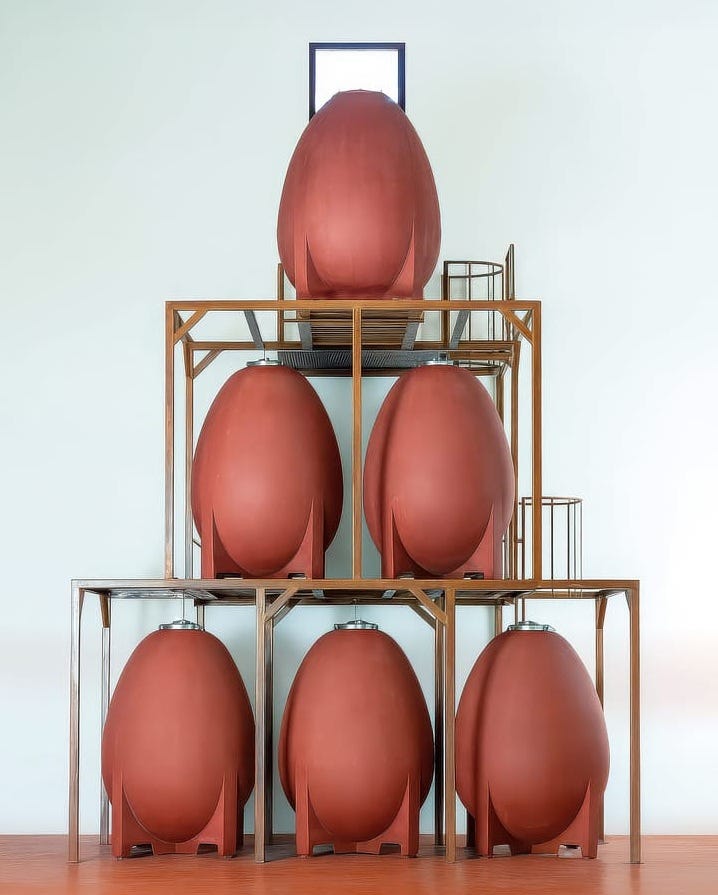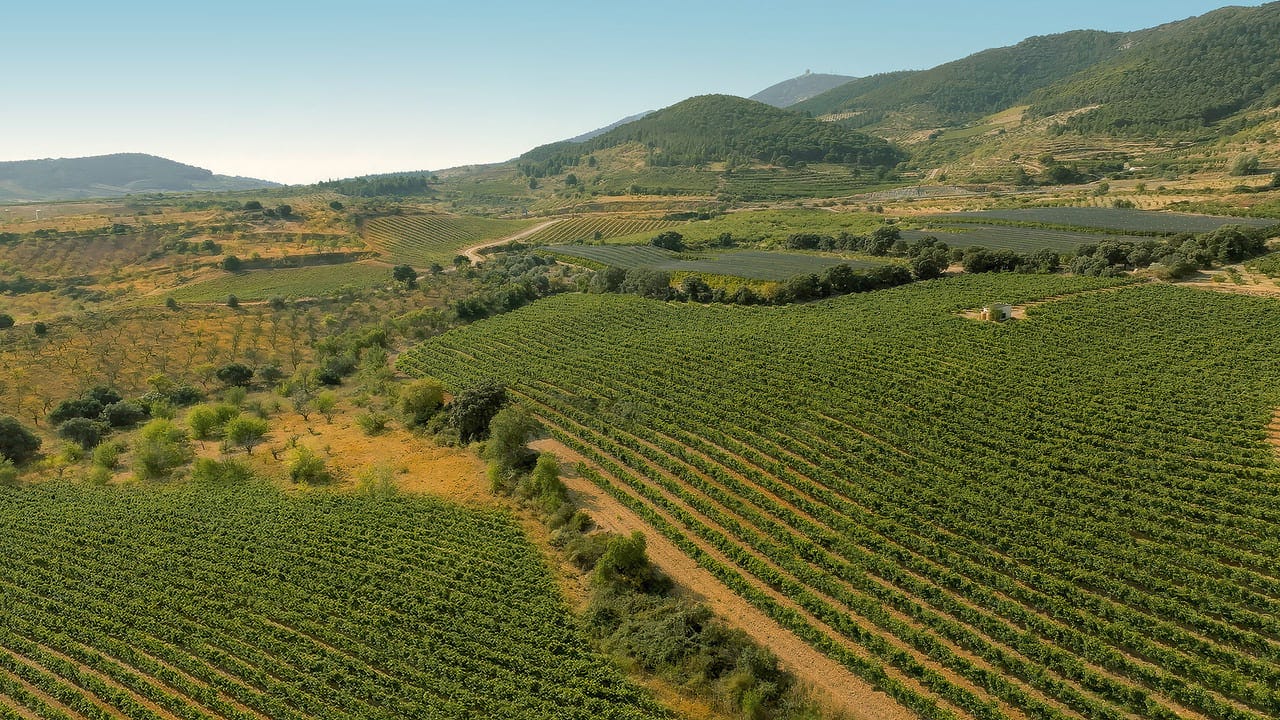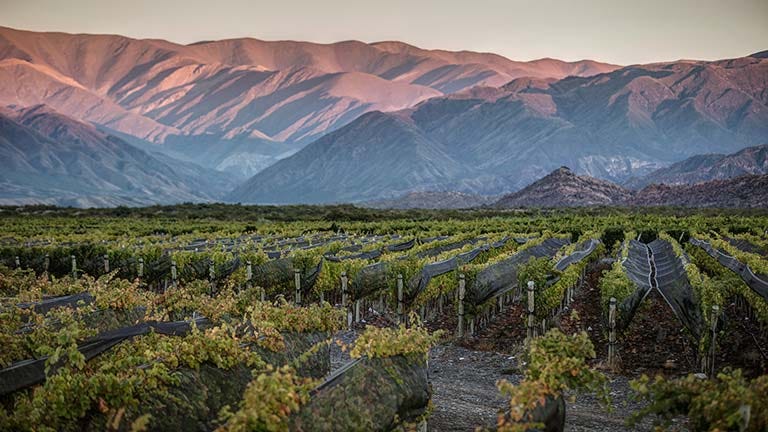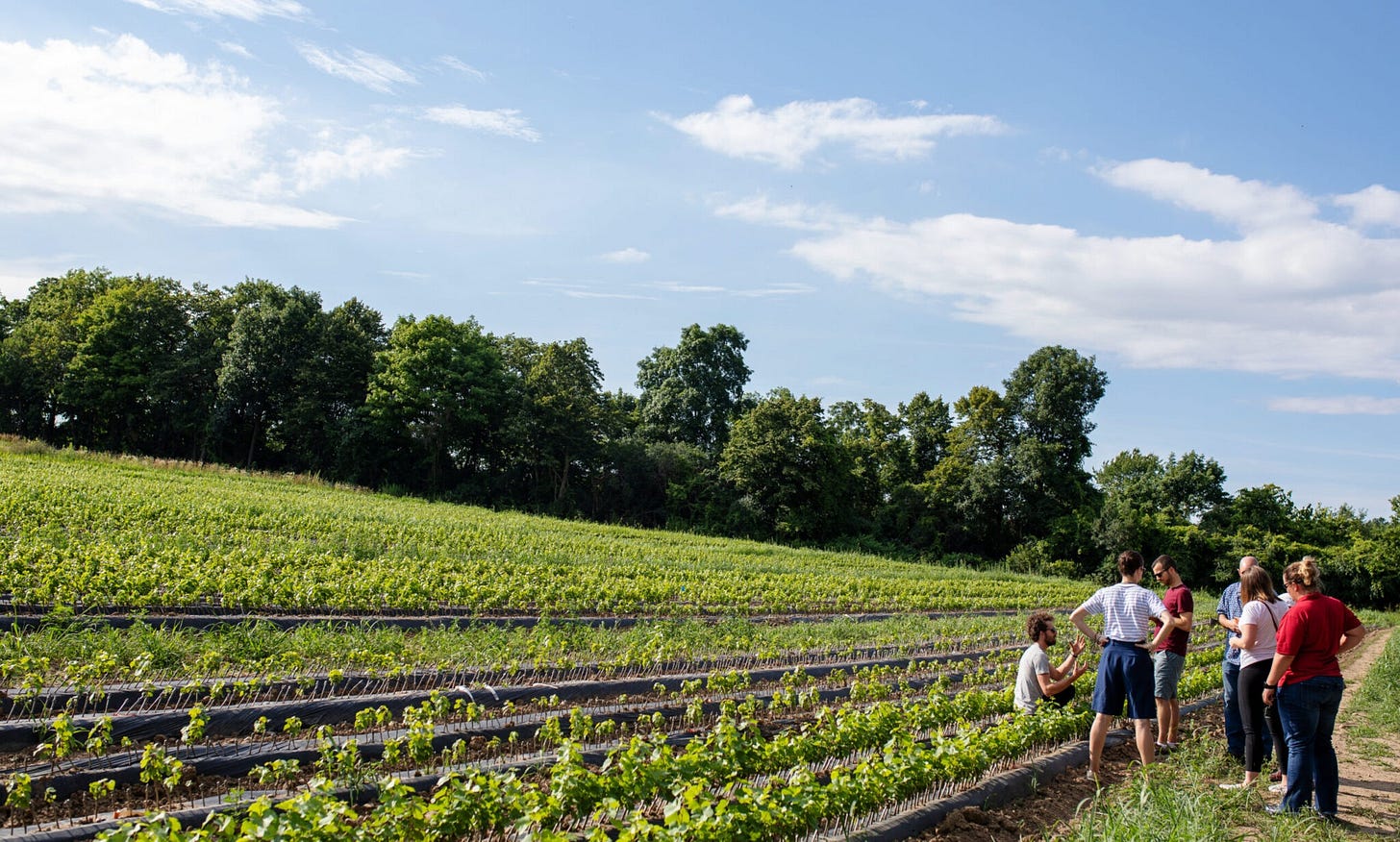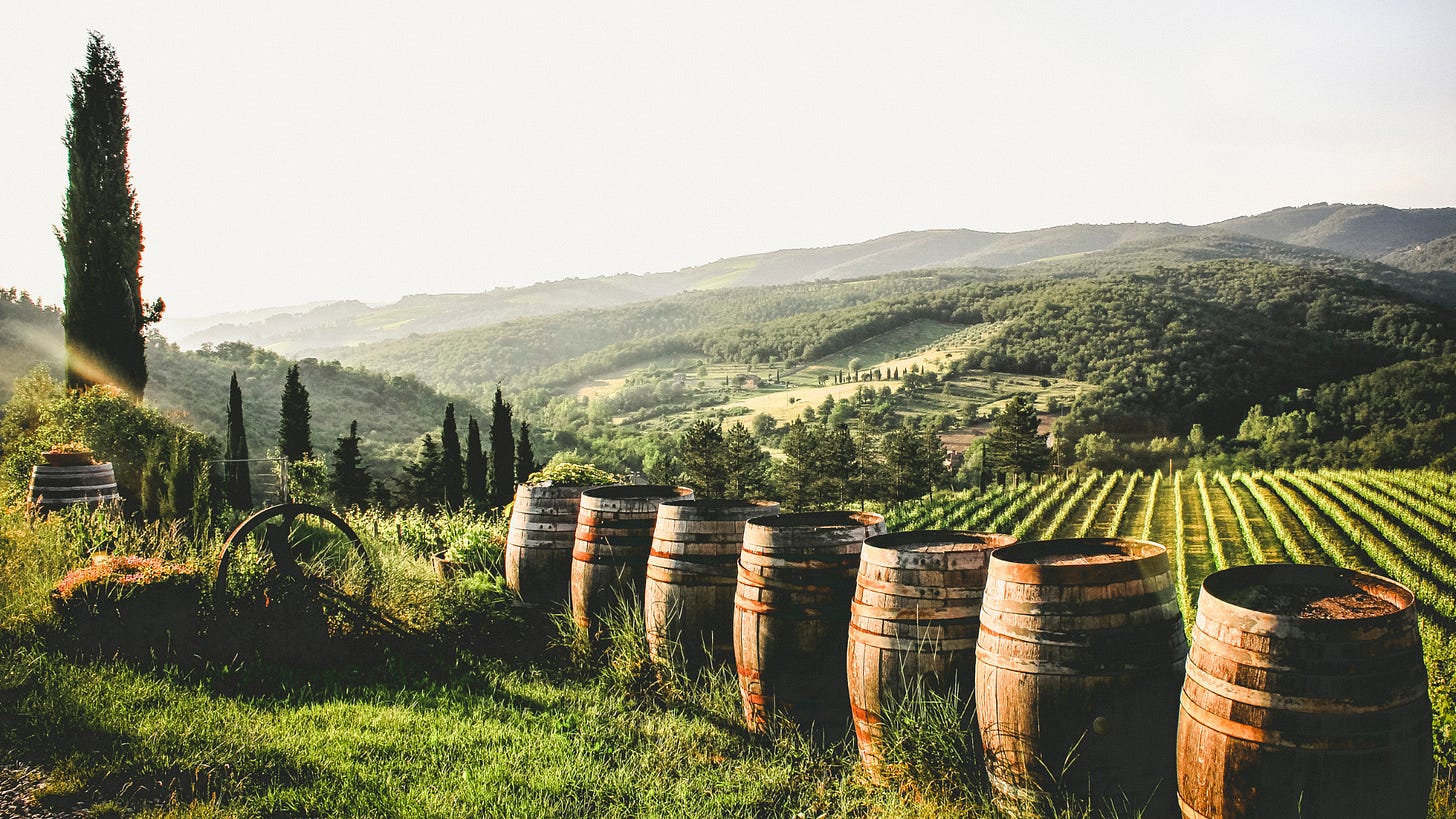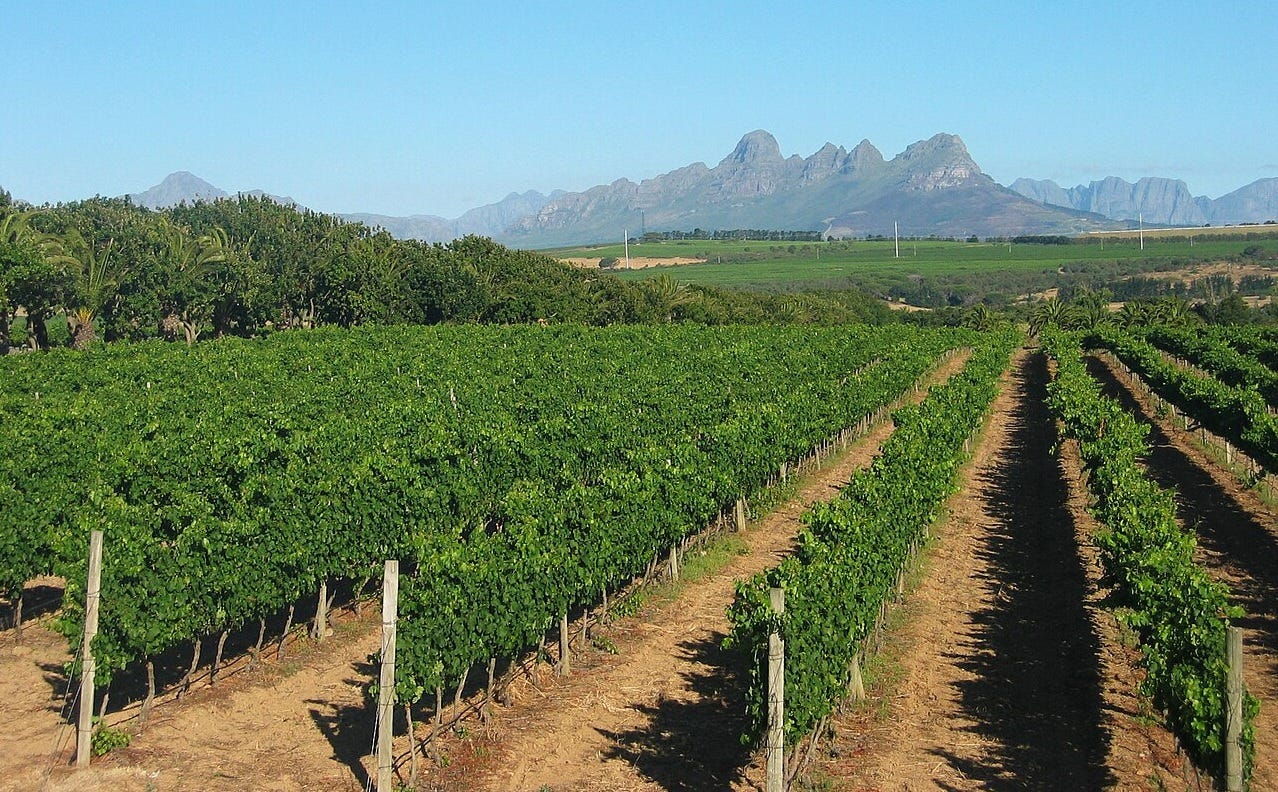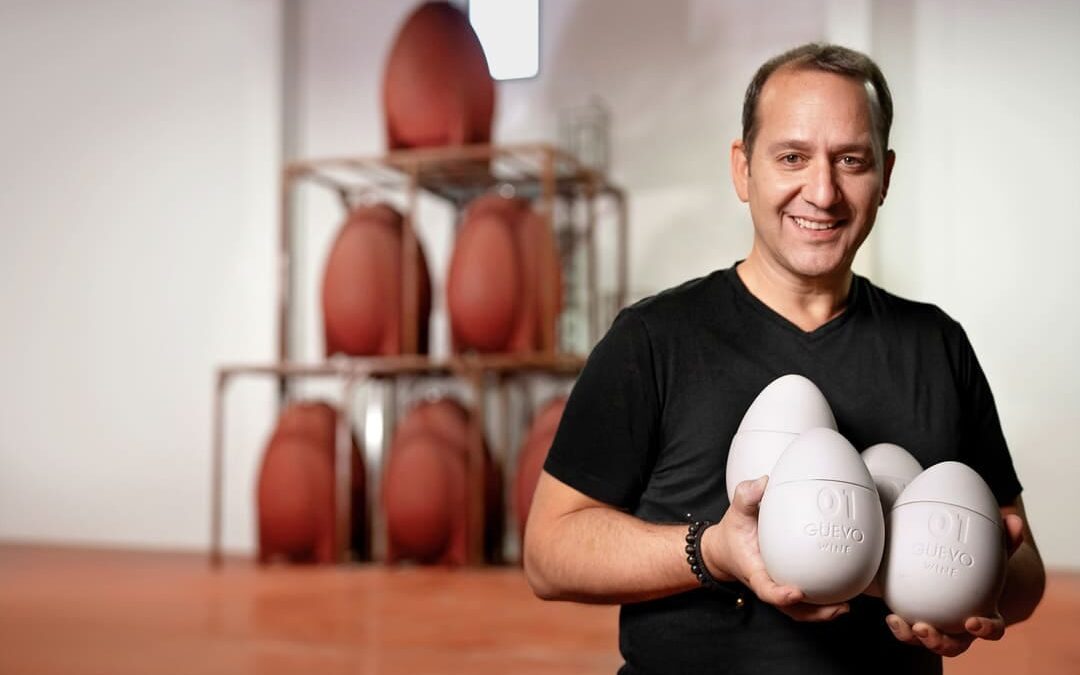
by lspeed | Nov 6, 2025 | WINES: UNCORKING THE MYSTERY
In the hills of Spain’s Sistema Ibérico, at 800 meters above sea level, winemaker César Langa has set out to challenge the conventions of modern enology. His project, Güevo Wine, positions itself as a “wine revolution”: a bold blend of ancient amphora wisdom, Sherry-style solera blending, and a futuristic ceramic bottle said to “breathe.” Behind the marketing poetry lies a deeper question for the trade: can such a fusion of past and future truly enhance terroir, stability, and longevity, or is it an example of wine romanticism?
The Ethernum Method
At the core of Güevo’s philosophy lies the Ethernum Method, described as their system combining native grapes, indigenous yeasts, and a criaderas y solera structure, a reference borrowed from Sherry aging traditions. The technique layers multiple vintages in a fractional-blending sequence: each year, a portion of the oldest wine (the solera) is drawn, then replenished by successively younger “criaderas.” The result is an evolving continuum that theoretically ensures consistency, complexity, and maturity.
This concept is hardly unorthodox. The solera system has long been celebrated in Jerez and Madeira for preserving quality and depth over decades, and has become a mainstay of upmarket rum production methods in Latin America. It introduces controlled oxidation and integrates the character of multiple harvests into a seamless whole. Enologists at the University of Cádiz have documented how solera aging maintains stable phenolic balance and promotes long-chain ester formation, which can add complexity and textural richness over time.
What differentiates Güevo’s take is the marriage of solera blending with concrete egg fermentation. In these ovoid vessels, fine lees circulate naturally, creating what the winery calls a “self-bâtonnage.” Studies at UC Davis and INRA Montpellier support the claim that egg-shaped fermenters enhance lees contact and achieve gentle micro-oxygenation. The result is textural roundness and freshness comparable to that of large neutral oak barrels, but without imparting wood aromatics.
Güevo now takes this further by presenting the “world’s first permeable ceramic bottle.”
A Bottle That Breathes
The company’s ceramic vessel is described as both ovoid and porous, mimicking the micro-oxygenation of concrete eggs and ancient amphorae. The idea is that the wine continues to evolve post-bottling, rather than entering stasis as it would in glass.
At first glance, this sounds revolutionary. Controlled oxygen transmission rates (OTR) are well understood in barrel and closure science, yet applying them to the bottle itself is rare. Most ceramic materials have OTR values far higher than glass, raising potential risks of premature oxidation or microbiological instability.
However, laboratory studies published in Food Chemistry (2019) show that fine-grained ceramic composites can be engineered to allow oxygen ingress at rates comparable to natural cork. Enough to maintain slow aging but not spoilage. If Güevo’s material meets that threshold, the concept could hold real technical merit.
Wine-packaging expert Dr. Enrico Chiaranda (University of Padua) notes that “controlled permeability can extend reductive capacity while preventing hydrogen sulfide formation, provided the vessel’s porosity is uniform.” In other words, under ideal design, a breathable ceramic bottle could keep wine evolution stable. Still, large-scale validation is lacking, and peer-reviewed data on Güevo’s bottle have yet to be published.
For sommeliers, the key question is whether such post-bottling evolution is beneficial. In theory, a slow exchange of oxygen may soften tannins or integrate volatile compounds, similar to the subtle development seen in fine wines under natural cork. In practice, without precise calibration, oxidation could outpace maturity.
The Amphora Connection
To understand Güevo’s aesthetic and philosophical drive, we must look back. Amphora winemaking predates barrels by several millennia. Archaeological findings from Georgia’s Kakheti region show qvevri (large clay jars) used for fermentation and storage as early as 6000 BCE. Similar vessels spread through Greece, Italy, and the Roman Empire, where amphorae became both aging and transport containers.
The common denominator: porous clay that allowed gentle micro-oxygenation and thermal stability. In essence, amphorae were the world’s first breathable wine containers. Their egg-like geometry promoted natural convection of lees, the same effect mimicked by modern concrete eggs.
Today’s amphora revival draws from this lineage. Producers from Portugal’s Alentejo to Italy’s Friuli and Oregon’s Willamette Valley now use terracotta vessels for natural or “orange” wines, emphasizing texture, minerality, and purity. According to Decanter (2023), “amphora aging allows the grape’s intrinsic flavor to shine without oak’s aromatic overlay, creating wines of clarity and earth-driven identity.”
Güevo Wine’s Ethernum Method clearly belongs to this lineage, even if it reinterprets it through modern material science. Its “breathing bottle” concept is, in spirit, a continuation of the ancient amphora’s living exchange with its environment.
Terroir & Yeast
Güevo places equal weight on indigenous yeast fermentation, citing both Saccharomyces and non-Saccharomyces strains as contributors to complexity. Research supports this: a 2021 paper in Frontiers in Microbiology found that native yeast consortia increase ester and thiol diversity, leading to more nuanced aromatics.
Yet, wild fermentations also carry unpredictability. Fermentation biologists from the Australian Wine Research Institute warn that spontaneous ferments can result in variable alcohol yields, VA (volatile acidity), or stuck fermentation if poorly managed. Güevo’s use of native yeast thus aligns with the natural-wine ethos but requires disciplined cellar hygiene and monitoring to ensure stability.
In their high-altitude vineyards of El Frasno, the focus on local grape varieties such as Parrel, Almolda, Mazuela (Carignan), and Garnacha further reinforces the authenticity message. Altitude, indigenous microbiota, and low-input farming connect the project to the global trend of “wines that speak the landscape.”
Sustainability & Ethos
Güevo Wine’s environmental positioning is strong: organic and biodynamic viticulture, zero synthetic inputs, low sulfites, no plastics, and local community investment. These align with global movements in regenerative viticulture and carbon-light production. While Güevo offers no third-party certifications, its rhetoric mirrors the sustainability frameworks adopted by producers in Demeter and Ecocert networks.
For restaurants and wine professionals, such commitments are increasingly commercially relevant. Consumers under 40 show higher purchasing preference for “planet-positive” products, particularly when storytelling aligns authenticity with measurable ethics.
Skepticism & Validation
Not all claims can be taken at face value. Güevo cites European Union recognition for innovation, but no official patent or grant reference is provided. Similarly, calling the packaging “the world’s first permeable wine bottle” may be true in a narrow sense, but similar research exists. This includes Vinolok’s oxygen-controlled closures and Amphora Barcelona’s clay bottles used for natural wines.
Still, even if some claims stretch marketing boundaries, the technical ambition is genuine. By attempting to merge solera continuity, amphora-like evolution, and sustainable materials, Güevo sits within a credible movement toward low-intervention, terroir-driven winemaking. Framed through avant-garde design.
A New Wine Story
For sommeliers, restaurateurs, and importers, projects like Güevo represent a new storytelling frontier. They provide:
-
A sensory alternative to oak-dominated profiles: wines defined by purity, texture, and freshness.
-
Sustainability narratives that resonate with environmentally aware diners.
-
Educational value, allowing staff to discuss amphora history, solera blending, and micro-oxygenation in accessible terms.
-
Portfolio differentiation, appealing to adventurous drinkers seeking authenticity without rusticity.
However, these wines must be evaluated on merit, not myth. Sommeliers should monitor bottle evolution and serve the wines with appropriate context, emphasizing that permeability and “living” maturation are deliberate features, not flaws.
The Return Of Living Wines
If the Ethernum Method succeeds technically, it would be a meaningful evolution in how wine connects to its origins. The project’s fusion of amphora physics, solera philosophy, and ecological design speaks to a broader cultural desire. To make wines that breathe, evolve, and express place long after the cork (or ceramic cap) is sealed.
Güevo Wine provides hope that wine innovation does not always mean breaking with the past. Sometimes, progress lies in revisiting forgotten wisdom through modern understanding. A reminder that winemaking still revolves around a single truth, wine as a dialogue between earth, time, and human imagination.
Image Credit: https://www.guevowine.com
_ _ _
© CHURRASCO PHUKET STEAKHOUSE / ALL RIGHTS RESERVED
Reprinting, reposting & sharing allowed, in exchange for a backlink and credits
Churrasco Phuket Steakhouse serves affordable Wagyu and Black Angus steaks and burgers. We are open daily from 12noon to 11pm at Jungceylon Shopping Center in Patong / Phuket.
We are family-friendly and offer free parking and Wi-Fi for guests. See our menus, reserve your table, find our location, and check all guest reviews here:
https://ChurrascoPhuket.com/
#Churrascophuket #jungceylon #phuketsteakhouse #affordablewagyu #wagyu
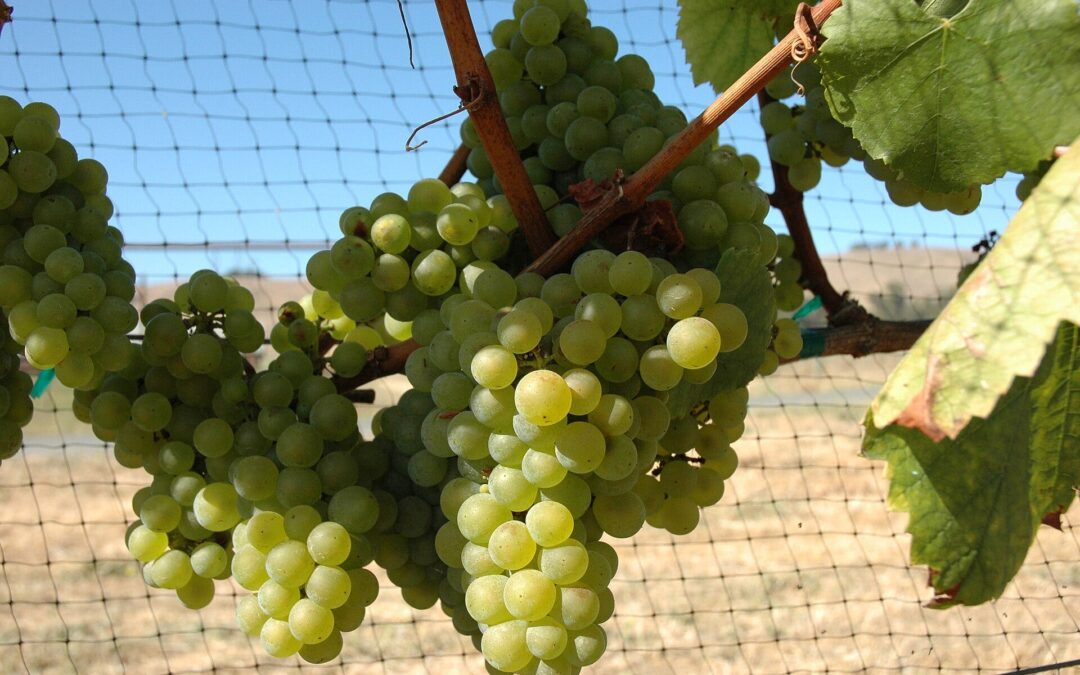
by lspeed | Nov 1, 2025 | WINES: UNCORKING THE MYSTERY
Roughly a decade ago, ordering a Chardonnay in the U.S. almost guaranteed a glass that tasted as though it had spent months steeping in wood chips. The oaky craze dominated, much to my dismay. Thankfully, that fad has faded into history alongside the fidget spinner and Argyle socks, giving us space to reconsider both the merits and the missteps of this approach to winemaking.
Few grape varieties invite such exploration of stylistic dichotomy as Chardonnay. Its ability to express both terroir and technique makes it a fixture in professional tasting rooms and wine programs. And this versatility feeds the debate between wooded and unwooded Chardonnay, a contrast that continues to shape how drinkers, critics, and sommeliers interpret this grape.
Context & Evolution
Chardonnay’s relationship with oak originates in Burgundy, where barrel fermentation and Élevage were once driven by practicality rather than stylistic intent. Oak casks were the standard storage medium for centuries. Over time, winemakers observed that maturation in wood enhanced complexity, texture, and stability. This practice evolved into a signature of the region’s great appellations (Meursault, Puligny-Montrachet, and Chassagne-Montrachet) where nuanced use of French oak remains the benchmark for refinement.
The unwooded style, by contrast, emerged much later as a deliberate statement of modern winemaking. From the 1970s onward, advances in stainless-steel technology allowed for precise temperature control and reductive handling, preserving freshness and primary fruit. By the late 1980s, this technical option had become a stylistic counterpoint, first in Chablis and subsequently in the New World, championed by producers seeking purity over opulence. The unoaked Chardonnay became not merely a reaction but an assertion of terroir and restraint.
Competing Profiles
Wooded Chardonnay owes its character to controlled oxygen ingress and flavor integration from oak. Depending on cooperage origin, toast level, and age, barrels contribute notes of vanilla, toasted hazelnut, clove, and brioche. Malolactic fermentation, frequently employed alongside barrel aging, adds lactic roundness and textural weight. The resulting profile tends toward richness, with aromas of baked apple, pear compote, and crème brûlée, supported by moderate acidity and a viscous mid-palate.
Unwooded Chardonnay, in contrast, foregrounds varietal precision. Stainless steel or concrete fermentation preserves volatile esters and crisp acidity. The wines display linearity, freshness, and fruit purity, with flavors of green apple, lemon zest, white peach – and in cooler climates, saline minerality. Texture is derived not from oak but from lees contact and bâtonnage, techniques that build subtle creaminess without sacrificing clarity. These are wines of articulation rather than amplitude.
Geography & Climate
Wooded Chardonnay Strongholds
-
Burgundy (France): The Côte de Beaune remains the archetype, demonstrating how fine-grained oak amplifies, rather than obscures, site character.
-
California: Regions such as Sonoma’s Russian River Valley and Carneros favor expressive barrel-fermented styles that balance ripe fruit and spice.
-
Australia: Margaret River and Yarra Valley producers have refined a contemporary model of moderate alcohol, restrained oak, and taut acidity.
-
South Africa: Elgin and Stellenbosch continue to push for precision in barrel selection and lees integration.
Unwooded Chardonnay Hubs
-
Chablis (France): The global reference for unoaked Chardonnay, shaped by Kimmeridgian limestone and cool maritime air.
-
New Zealand: Marlborough and Hawke’s Bay deliver vivid fruit expression underpinned by brisk acidity.
-
Australia: Adelaide Hills and Mornington Peninsula emphasize purity and minerality through stainless steel vinification.
-
South Africa: Coastal vineyards yield unoaked styles marked by tropical aromatics and saline lift.
Food, Function, and Pairing
From a professional standpoint, the choice between wooded and unwooded Chardonnay determines not only stylistic direction but also gastronomic function.
-
Wooded Chardonnays align with richer cuisines: butter-based sauces, shellfish, or poultry, where texture and oak spice complement umami depth.
-
Unwooded styles are suited to lighter or high-acid dishes: ceviche, oysters, and sushi, where freshness provides contrast and precision.
In market terms, wooded Chardonnay remains dominant in premium tiers, where barrel aging justifies price and cellar potential. Unoaked examples, while generally earlier-drinking, have gained traction in markets favoring transparency, lower alcohol, and sustainability.
Pursuing Balance
The binary distinction is softening as winemakers experiment with hybrid approaches, partial barrel fermentation or short élevage in neutral oak, to achieve balance. This middle ground satisfies consumers seeking both vibrancy and textural complexity. Additionally, reduced new oak usage, larger-format barrels, and acacia or foudre aging reflect a broader movement toward subtlety.
For professionals, the dichotomy between wooded and unwooded Chardonnay is less about opposition than calibration. Both express legitimate winemaking philosophies, one emphasizing transformation, the other translation. Whether in the precision of Chablis or the generosity of Sonoma, Chardonnay continues to serve as the medium through which craftsmanship and site converge.
Image Credit: Wikipedia.org
_ _ _
© CHURRASCO PHUKET STEAKHOUSE / ALL RIGHTS RESERVED
Reprinting, reposting & sharing allowed, in exchange for a backlink and credits
Churrasco Phuket Steakhouse serves affordable Wagyu and Black Angus steaks and burgers. We are open daily from 12noon to 11pm at Jungceylon Shopping Center in Patong / Phuket.
We are family-friendly and offer free parking and Wi-Fi for guests. See our menus, reserve your table, find our location, and check all guest reviews here:
https://ChurrascoPhuket.com/
#Churrascophuket #jungceylon #phuketsteakhouse #affordablewagyu #wagyu
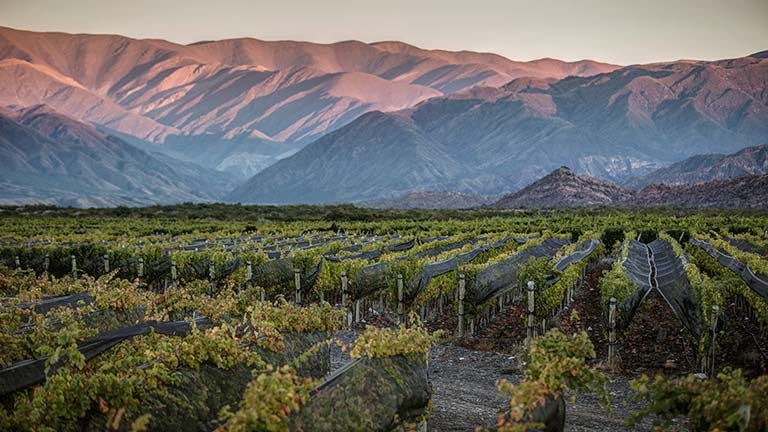
by lspeed | Oct 5, 2025 | WINES: UNCORKING THE MYSTERY
San Juan stands as Argentina’s second pillar of production. Essential in terms of volume, but increasingly strategic in terms of diversity. While Mendoza dominates the image of Argentine wine internationally, San Juan offers an alternative profile with warmer, spicier reds, fortified traditions, and promising high-altitude terroirs that can complement Argentina’s broader offering.
Located to the north of Mendoza, it stretches along the foothills of the Andes at altitudes ranging from 650 to 1,400 meters. With around 47,000 hectares under vine, it accounts for roughly a quarter of the country’s vineyard area. The region’s dry, sunny climate and access to meltwater from the Andes through the San Juan and Jáchal rivers provide the basis for a viticulture that has historically leaned toward volume but is increasingly quality-focused.
History
Winegrowing in San Juan dates back to the 16th century, when Spanish settlers introduced vines for sacramental and local consumption. For much of the 20th century, San Juan was known primarily as a bulk-wine and brandy source. Large cooperatives dominated production, and grapes were grown mainly for yield. Over the past three decades, however, investment from domestic and international producers, along with new vineyard management and irrigation techniques, has shifted San Juan toward producing higher-quality wines with clearer varietal identity.
Climate
San Juan is markedly warmer and drier than Mendoza. The region averages more than 300 days of sunshine annually, with very low rainfall. The desert-like conditions require controlled irrigation, which has historically been supplied by river channels but now increasingly involves drip systems. The intense solar exposure ripens grapes quickly, producing full-bodied wines with higher alcohol levels. Cooling influences come from elevation and the strong Zonda wind, a hot, dry current from the Andes that reduces disease pressure but can affect yields.
Terroir
San Juan is divided into several valleys, each with distinct conditions:
-
Tulum Valley: The traditional heart of production near the city of San Juan, historically dominated by high-yielding vineyards for bulk wine and table grapes.
-
Zonda Valley: Higher altitude, with cooler nights and potential for more balanced reds.
-
Ullum Valley: Small but promising, known for Syrah and Cabernet Sauvignon.
-
Pedernal Valley: A newer frontier at elevations above 1,300 meters, where limestone soils and cooler conditions deliver freshness and minerality, particularly in Malbec and Chardonnay.
Pedernal in particular has drawn attention as a site capable of producing wines with international competitiveness.
Grapes & Styles
Traditionally, San Juan has been a center for Syrah, which finds a natural home in the region’s hot, sunny conditions, yielding wines with ripe fruit, spice, and robust structure. The variety has become something of a signature for San Juan in both domestic and export markets.
Other key red grapes include Malbec, Bonarda, Cabernet Sauvignon, and Merlot. Whites such as Chardonnay, Torrontés, and Viognier are present but represent a smaller share. San Juan also has a long history of producing table grapes and raisins, which remain important to the local economy.
In addition, San Juan is Argentina’s primary source of fortified wines and brandy, continuing a tradition established in the 19th century.
Industry Shifts
While San Juan was once overshadowed by Mendoza, recent decades have seen a steady repositioning. Private wineries, often with international partnerships, are investing in higher-altitude sites such as Pedernal, employing modern vinification techniques, and branding San Juan as more than a bulk supplier. Cooperative wineries have also adapted, developing premium labels alongside their traditional high-volume products.
Research institutes and local government have supported diversification, promoting varieties suited to the climate, improving irrigation efficiency, and encouraging sustainable vineyard practices. The focus has shifted from quantity to differentiation—especially around Syrah and high-altitude Malbec.
International Reach
San Juan wines, especially Syrah and blends, are gaining recognition abroad, though they remain less prominent than Mendoza’s Malbec. Exports go mainly to the United States, Brazil, the UK, and some Asian markets. The balance between bulk shipments and bottled, branded wines is changing gradually in favor of the latter, reflecting the global demand for regional identity and terroir-driven narratives.
Image Credit: https://api.winesofargentina.org/uploads/web/regiones/cuyo/san-juan/galeria/san-juan-vinedos.jpg
_ _ _
© CHURRASCO PHUKET STEAKHOUSE / ALL RIGHTS RESERVED
Reprinting, reposting & sharing allowed, in exchange for a backlink and credits
Churrasco Phuket Steakhouse serves affordable Wagyu and Black Angus steaks and burgers. We are open daily from 12noon to 11pm at Jungceylon Shopping Center in Patong / Phuket.
We are family-friendly and offer free parking and Wi-Fi for guests. See our menus, reserve your table, find our location, and check all guest reviews here:
https://ChurrascoPhuket.com/
#Churrascophuket #jungceylon #phuketsteakhouse #affordablewagyu #wagyu
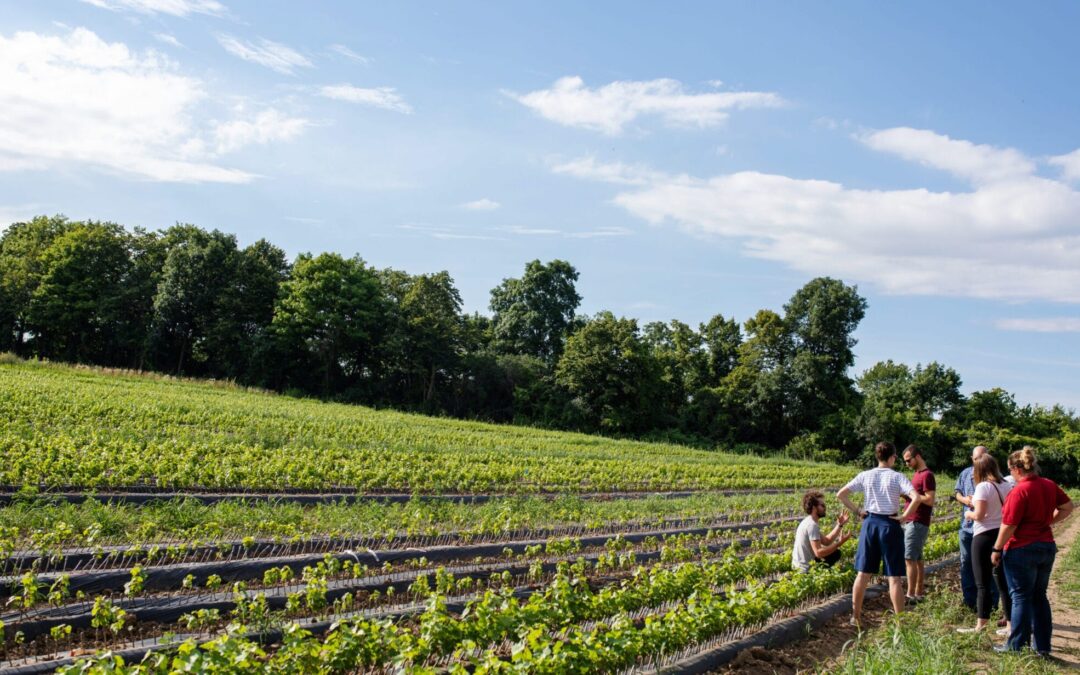
by lspeed | Sep 21, 2025 | WINES: UNCORKING THE MYSTERY
New York is the clear underdog in American wine, overshadowed by the volume and global marketing power of California, and to some extent by the boutique cool of Oregon and Washington. Yet, New York is home to some of the oldest vineyards in the country and continues to a number of produce wines that can hold their own alongside bottles from Europe and the New World. That said, the path to international recognition has been uneven and is ongoing.
Hybrid Roots
New York’s winemaking history stretches back to the 1600s, with commercial wine production emerging in earnest in the 19th century. However, much of the early wine output relied on native American grape varieties like Concord and Catawba. High in acidity and unusual in character, they are used mostly for sweet wines, sacramental purposes, and table grapes. These were hardy, disease-resistant grapes but not well-suited to the production of dry, refined wines expected by global wine markets.
The shift toward European Vitis vinifera varieties like Riesling and Chardonnay came relatively late and was pioneered in the 1950s by Dr. Konstantin Frank in the Finger Lakes. His success in cultivating vinifera in cold climates helped reposition New York’s winemaking identity. Still, hybrid grapes remain common today, particularly in lower-priced and regional wines, which continue to account for a substantial portion of overall production.
Key Regions
New York’s wine landscape is dominated by five main AVAs (American Viticultural Areas), each with its own conditions and identity:
-
Finger Lakes: The best-known region, especially for Riesling. The deep glacial lakes create favorable microclimates that help mitigate frost and extend ripening.
-
Long Island: Produces Merlot, Cabernet Franc, and Chardonnay in a maritime climate reminiscent of Bordeaux, though often with lower alcohol and higher acidity.
-
Hudson River Region: One of the oldest growing areas, still working to distinguish itself beyond local markets.
-
Lake Erie & Niagara Escarpment: Focus on hybrids and Concord grapes, with a growing interest in quality-focused vinifera and ice wines.
Among vinifera grapes, Riesling stands out. It often yields crisp, mineral-driven wines with aging potential, drawing comparisons to cooler-climate German Rieslings. Cabernet Franc and Merlot from Long Island have also shown promise, though consistency is a challenge due to vintage variation and limited economies of scale.
Wine Styles
The styles produced across New York vary widely, from dry whites and reds to dessert wines and traditional method sparkling wines. At the premium end, small producers are making site-specific, low-intervention wines with clear ambition and increasing finesse. However, much of the state’s output still caters to local or entry-level markets, with wines that are sweeter, simpler, and priced accordingly. This split between artisanal ambition and mass-market practicality reflects the region’s main challenges.
Room to Grow
How do New York wines compare internationally? At the high end, some Rieslings from producers like Hermann J. Wiemer, Ravines, and Forge Cellars have earned critical praise and scored well in blind tastings against German and Alsatian peers. These successes are real but relatively isolated. In red wine, Long Island’s Bordeaux-style blends are often elegant and restrained but face stiff competition from Old World and New World wines at similar price points that offer greater depth or brand recognition.
There is also the issue of scale. Many New York wineries are small, limiting their distribution and price competitiveness abroad. For wine buyers outside the U.S., the state’s name still lacks the cachet of Burgundy, Napa, or even Marlborough. This affects not just retail but placement on export-focused restaurant wine lists.
Recognition & Realism
New York wines have received increasing attention at competitions like the International Wine Challenge and Decanter World Wine Awards, particularly in white and sparkling categories. Still, international market penetration remains limited. For now, New York’s wines are better known and appreciated by sommeliers, wine critics, and curious local drinkers rather than by the broader wine-buying public.
Whether that will change depends less on quality, and more on branding, market access, and consistent storytelling. For all its achievements, New York wine still needs clearer positioning: not just as “not California” or “Riesling from the East,” but as a region with its own voice.
More Information: https://newyorkwines.org/
Image Credit: https://newyorkwines.org/wp-content/uploads/2020/04/2019-FLX-Vineyard-Visit-Photo-Credit-to-Rima-Brindamour-102-scaled.jpg
_ _ _
© CHURRASCO PHUKET STEAKHOUSE / ALL RIGHTS RESERVED
Reprinting, reposting & sharing allowed, in exchange for a backlink and credits
Churrasco Phuket Steakhouse serves affordable Wagyu and Black Angus steaks and burgers. We are open daily from 12noon to 11pm at Jungceylon Shopping Center in Patong / Phuket.
We are family-friendly and offer free parking and Wi-Fi for guests. See our menus, reserve your table, find our location, and check all guest reviews here:
https://ChurrascoPhuket.com/
#Churrascophuket #jungceylon #phuketsteakhouse #affordablewagyu #wagyu

by lspeed | Sep 7, 2025 | WINES: UNCORKING THE MYSTERY
Ever tried Turkish wines? If not, it’s about time to do so. On Turkey’s Aegean coast, the town of Urla is quietly raising its profile in the international wine scene. With a winemaking history dating back over 6,000 years, Urla was once a vital hub in the ancient Ionian city of Klazomenai. Today, it’s experiencing a renaissance, blending millennia-old traditions with cutting-edge innovation to produce wines that are gaining some acclaim.
Urla’s connection to wine stretches deep into antiquity. As early as the 6th century BC, Greek settlers introduced winemaking techniques that had evolved from even older Anatolian civilizations like the Hittites and Phrygians. Historical records suggest that Anatolian wines were traded to Italy and France centuries before those countries developed their own wine cultures. Notably, the Muscat grape, known for its sweet, floral profile, was believed to have originated from this region. Its modern Turkish descendant, Bornova Misketi, remains a signature varietal in Urla today.
Forgotten Grapes
Modern winemakers in Urla are bringing indigenous varietals like Urla Karası, Foça Karası, and Gaydura bak to life. Once nearly extinct, they are being carefully nurtured and reintroduced into production. This commitment to heritage not only preserves ancient flavors but also distinguishes Urla’s wines in an increasingly globalized market.
Tailor-Made Terroir
Urla’s climate is a winemaker’s dream. Long, hot summers are moderated by cool Aegean breezes, and mild, wet winters nourish the vines without stressing them. The region’s mineral-rich soils lend depth and complexity to the wines, while sustainable and chemical-free practices have become the norm. Many wineries have embraced gravity-flow systems to ensure gentle handling of grapes, resulting in wines of remarkable purity and elegance.
Rising Wine Tourism
Urla’s commitment to quality has not gone unnoticed. Wines from the region have begun to win awards at international competitions, positioning Urla as a rising star in viticulture. Meanwhile, the establishment of the Urla Vineyard Route (Urla Bağ Yolu) has transformed the area into a destination for wine lovers, complete with boutique wineries, scenic vineyard walks, and gourmet restaurants. Euphemistically referred to as the “Tuscany of Turkey,” Urla has become a sought-after destination for those seeking authentic wine experiences.
Leading Producers
Among the most celebrated names is Urla Winery, known for its commitment to both local and international varietals. Their flagship wines, like “Tempus”, a robust blend of Merlot, Syrah, Cabernet Sauvignon, Cabernet Franc, and Petit Verdot, and “Nero,” combining Nero d’Avola and Urla Karası, showcase the versatility of the region.
USCA Winery takes a poetic approach, naming its wines after Shakespearean sonnets and working closely with French oenologist Antoine Bastide d’Izard to craft refined offerings. Bornova Misketi and Foça Karası feature prominently in their portfolio.
Urlice Vineyards, pioneers of the modern Urla wine movement since 1997, specialize in organic viticulture and oak-aged reds from Cabernet Sauvignon, Merlot, and Syrah. Their vineyard experiences have made them a favorite among visiting wine enthusiasts.
Other notable players include MMG Winery, known for sustainable farming and night harvesting to preserve grape integrity, and HUS Winery, which fuses Turkish and Chilean traditions to produce elegant Syrah and Grenache wines.
Popular Wine Styles
Red blends dominate Urla’s wine scene, often marrying international varieties like Cabernet Sauvignon, Merlot, and Syrah with indigenous grapes such as Boğazkere and Urla Karası. These reds tend to be full-bodied, expressive, and rich in tannins, balanced by fresh acidity.
On the white side, wines crafted from Bornova Misketi, Chardonnay, and Sauvignon Blanc offer crisp, aromatic profiles perfect for the Mediterranean climate. Rosés are also gaining popularity, especially refreshing blends like Urla Winery’s “Serendias Roze,” made from Pinot Noir and Kalecik Karası.
Image Credit: https://phoenicia.travel/images/tours/288152134228155205297.png
_ _ _
© CHURRASCO PHUKET STEAKHOUSE / ALL RIGHTS RESERVED
Reprinting, reposting & sharing allowed, in exchange for a backlink and credits
Churrasco Phuket Steakhouse serves affordable Wagyu and Black Angus steaks and burgers. We are open daily from 12noon to 11pm at Jungceylon Shopping Center in Patong / Phuket.
We are family-friendly and offer free parking and Wi-Fi for guests. See our menus, reserve your table, find our location, and check all guest reviews here:
https://ChurrascoPhuket.com/
#Churrascophuket #jungceylon #phuketsteakhouse #affordablewagyu #wagyu
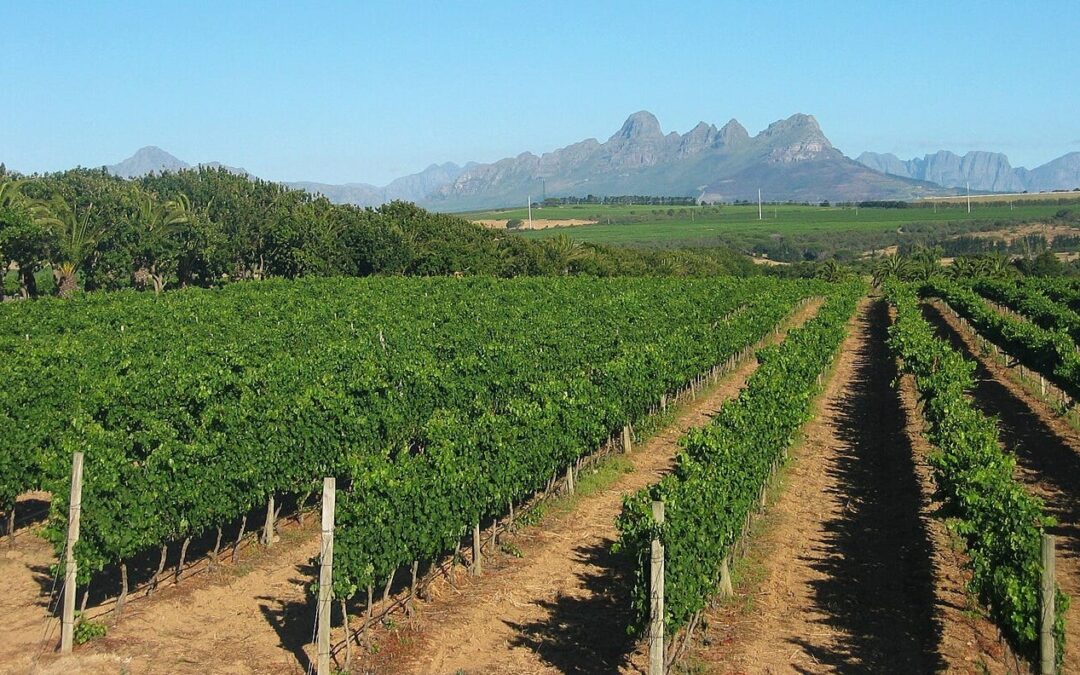
by lspeed | Aug 24, 2025 | WINES: UNCORKING THE MYSTERY
Stellenbosch is arguably South Africa’s commercially most significant wine region. Located just east of Cape Town, it serves as a cornerstone of the country’s wine industry in terms of volume, academic research, and international market recognition. With a mix of maritime influence, varied soils, and a long viticultural history, Stellenbosch is a versatile wine-growing zone capable of producing a wide range of styles.
Historical Background
Viticulture here dates back to the late 17th century, following the arrival of Dutch settlers and subsequently French Huguenots, who brought winemaking knowledge and grapevine cuttings to the Cape Colony. The fertile soils and Mediterranean-style climate made Stellenbosch a suitable location for grape cultivation, and by the 18th century, it had established itself as a key contributor to South African wine production.
Throughout the 19th and 20th centuries, the region saw shifts in vineyard management, production methods, and export strategies, particularly following the formation of the Koöperatieve Wijnbouwers Vereniging (KWV) in 1918, which regulated wine quality and exports. The end of apartheid in the early 1990s opened international markets to South African producers, prompting increased investment and modernization in Stellenbosch’s wine sector.
Grape Varieties and Wine Styles
Stellenbosch’s climate is classified as warm Mediterranean, moderated by Atlantic Ocean breezes from False Bay. This allows for the cultivation of both red and white grapes, although red varietals strongly dominate.
Red Grapes
-
Cabernet Sauvignon: The most planted and commercially important red grape in the region. Often used for varietal wines and blends, particularly in Bordeaux-style combinations.
-
Merlot: Commonly paired with Cabernet Sauvignon to soften blends, or bottled on its own.
-
Shiraz (Syrah): Frequently made in a ripe, full-bodied style; also appears in Rhône-style blends.
-
Pinotage: A uniquely South African grape, developed from a cross between Pinot Noir and Cinsaut. While polarizing in style and reception, it remains a regional staple.
White Grapes
-
Chenin Blanc: Although more associated with regions like Swartland, it is still grown in Stellenbosch and used for both dry and off-dry styles.
-
Sauvignon Blanc: Typically planted in cooler subzones, producing wines with herbal and citrus-driven profiles.
-
Chardonnay: Made in both oaked and unoaked versions, sometimes used in sparkling wines (Cap Classique).
The range of microclimates and soils within Stellenbosch range from granite and shale to sandstone and support the production of both single-varietal wines and complex blends.
Subregions
Stellenbosch is not a monolithic zone; it comprises several wards or subregions, each with distinct characteristics. Notable among these are:
-
Simonsberg-Stellenbosch: Known for structured reds.
-
Jonkershoek Valley: Cooler climate; suitable for Sauvignon Blanc and Cabernet-based wines.
-
Helderberg: Coastal influence; diverse plantings.
-
Bottelary Hills: Often associated with Pinotage and Shiraz.
These subregions allow for differentiated branding and marketing within the greater Stellenbosch designation.
Leading Producers
The region includes a mix of large-scale operations and smaller, privately-owned estates. While it is difficult to definitively rank producers, the following five are widely recognized within the trade for their historical significance, consistent quality, and international distribution:
-
Kanonkop Estate
Known for its long-standing commitment to Pinotage and Bordeaux blends. Family-owned since the early 20th century.
-
Meerlust Estate
One of the first to label a Bordeaux-style blend as “Rubicon,” which became a flagship South African wine.
-
Rust en Vrede
Focused almost exclusively on red wine. Frequently cited for its Shiraz and Cabernet Sauvignon.
-
Warwick Estate
Known for its trilogy of Bordeaux-style blends and experimentation with single-varietal expressions.
-
Spier Wines
One of the region’s oldest wine farms, combining large-scale production with a sustainability focus.
These producers vary in scale, but all have built international reputations based on consistent branding and quality.
Export Markets and Global Reception
Stellenbosch plays a central role in South Africa’s wine exports. Key markets include the United Kingdom, Netherlands, Germany, the United States, and China. The wines are often priced competitively compared to similar quality offerings from Europe and the New World, making them appealing to both on-trade and off-trade buyers.
Reception in global markets has generally been positive, especially in blind tastings where Stellenbosch reds frequently perform well. Cabernet Sauvignon and Bordeaux-style blends are the most likely to appear on international wine lists, while Sauvignon Blanc and Chenin Blanc hold appeal in retail environments.
Despite its relative success, the region still faces challenges such as currency fluctuation, vintage variation due to droughts, and residual perception issues in some markets tied to its apartheid-era legacy. Nonetheless, Stellenbosch remains one of South Africa’s most internationally visible appellations.
Image Credit: https://wikipedia.org
_ _ _
© CHURRASCO PHUKET STEAKHOUSE / ALL RIGHTS RESERVED
Reprinting, reposting & sharing allowed, in exchange for a backlink and credits
Churrasco Phuket Steakhouse serves affordable Wagyu and Black Angus steaks and burgers. We are open daily from 12noon to 11pm at Jungceylon Shopping Center in Patong / Phuket.
We are family-friendly and offer free parking and Wi-Fi for guests. See our menus, reserve your table, find our location, and check all guest reviews here:
https://ChurrascoPhuket.com/
#Churrascophuket #jungceylon #phuketsteakhouse #affordablewagyu #wagyu



